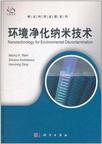环境净化纳米技术
出版时间:2011-10 出版社:科学出版社 作者:(美)拉姆 等著 页数:430 字数:584000
Tag标签:无
内容概要
本书由全球各个国家该领域的专家编撰而成,论述了使用纳米材料、过程、方法净化有毒废液、空气、地下水和废水的最新方法。本书讨论了使用纳米技术中和有害微生物、杀虫剂、重金属、化工废料、化学与生物制剂,以及其他有毒物质。涉及内容广泛,包含物理、化学、纳米材料技术、纳米结构,以及纳米净化技术等内容。
作者简介
作者:(美国)拉姆(Manoj K.Ram) (美国)Silvana Andreescu (美国)Hanming Ding
书籍目录
撰稿人
前言
第1章 利用纳米技术去污
Manoi K.Ram and Ashok Kumar
1.1 引言
1.2 饮用水净化
1.2.1 使用碳过滤器进行水净化
1.2.2 碳纳米管作为过滤材料
1.2.3 功能化碳纳米管用于吸附
1.3 Ti02与有机和无机化合物的光催化作用
1.4 酶净化
1.5 用于消除化学战剂的纳米材料
1.5.1 基于纳米零价铁的净化
参考文献
第2章 内皮层中空纤维纳米多孔膜的制备和应用
Guojun Zhan9,Shu!an ji,Zhongzhou Liu,and Maohong Fan
2.1 引言
2.2 内皮层中空纤维多孔膜的制备
2.3 内皮层中空纤维多孔膜在处理印钞废水上的应用
2.3.1 工艺流程
2.3.2 全规模的系统
2.3.3 厂区运行状态
2.3.4 经济效益分析_
2.4 内皮层中空纤维多孔膜在聚电解质多层膜(PEMMs)自组装上的应用
2.4.1 内皮层中空纤维聚电解质多层膜的自组装
2.4.2 内皮层中空纤维聚电解质多层膜的应用
致谢
参考文献
……
索引
章节摘录
版权页:插图:CHAPTER 1 DecontaminationUsing NanotechnologyManoj K. Ram and Ashok KumarNanotechnology Education Research Center,University of South Florida, Tampa, Florida1.1 Introduction Nanotechnology can be defined as the synthesis, characterization,and application of materials science and engineering and deviceswhose smallest functional organization in at least one dimension ison the nanometer scale (one billionth of a meter).1,2 The nanotechnologyhas grown to multidisciplinary scientific fields in a decade.Nanotechnology has shown huge potential in areas as diverse asdrug development, water decontamination, information and communicationtechnologies, and the production of stronger, lightermaterials and human health care.3,4 Water and air are two vital componentsof life on Earth; the existence of life on Earth is made possiblelargely because is owed by the presence of clean water and air inhabitual form because of their importance to metabolic processeswithin the body. Clean and fresh water and air are essential for thevery existence of life. Contamination of natural water sources bypathogenic microorganisms, heavy metal and groundwater withorganic pollutants are worldwide public health problems, leading towaterborne outbreaks of infectious hepatitis, viral gastroenteritis, andcancer. Other contaminants of water are microorganisms such asEscherichia coli (E. coli), amebas, Cryptosporidium, cholera, viruses,and bacteria.Immobilization of enzymes has been extensively studied for various large-scale applications due to the potential advantages including product purification, catalyst recycling, and continuous operation.The limiting factor of the application of enzyme immobilization is due to the rather poor biocatalytic efficiency of the immobilized enzymes,Therefore, strategies for improving biocatalytic effi-ciency through host materials' structure manipulation are currently being developed; both chemical and physical immobilization pro-cedures have been used for this purpose. Most physical methods are based on entrapment or encapsulation procedures of the bio-logical reagent in nanoporous materials (e.g., mesoporous silica,nanostructured polymers, and sol-gels). Porous matrices have the capacity to achieve high enzyme loading, but are limited by a high diffusion barrier for the substrate, restricting the accessibility to bioactive sites and affecting the overall effectiveness of the method.On the other hand, covalent attachment is carried out mainly by chemically binding the biocomponents onto the surface of both porous and nonporous materials. Enzymes can undergo covalent modification thrugh attachment of polymers or functional groups on their surface.
编辑推荐
《纳米科学进展系列:环境净化纳米技术》由科学出版社出版。
图书封面
图书标签Tags
无
评论、评分、阅读与下载
用户评论 (总计1条)
- 值得珍藏的一本书,挺好的,还可以练英语
